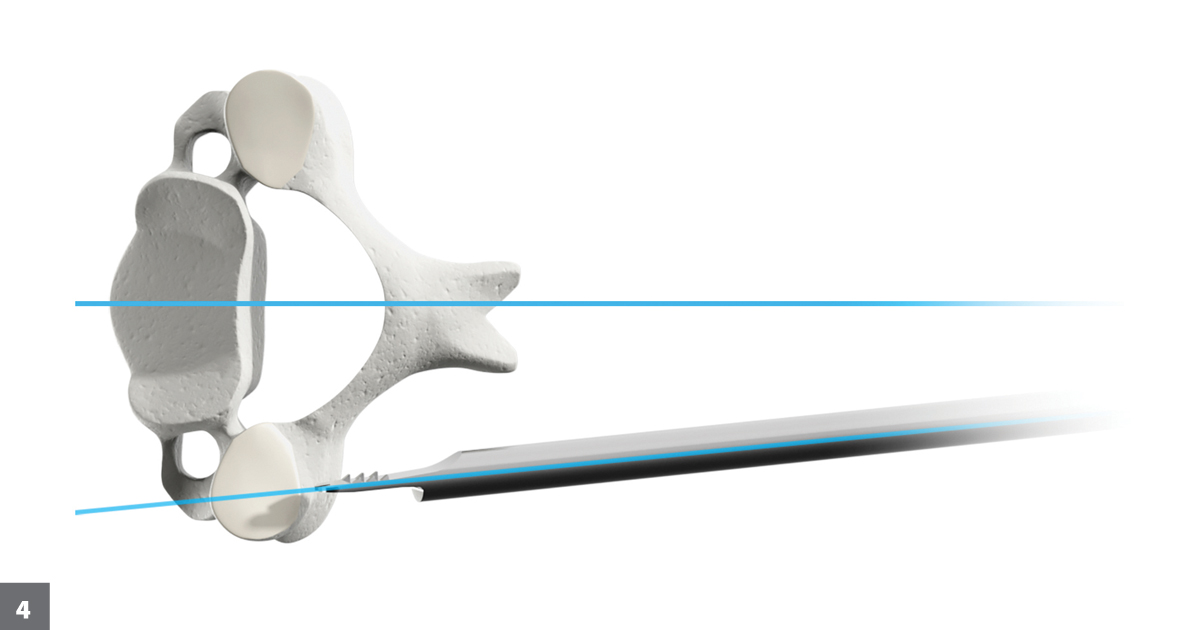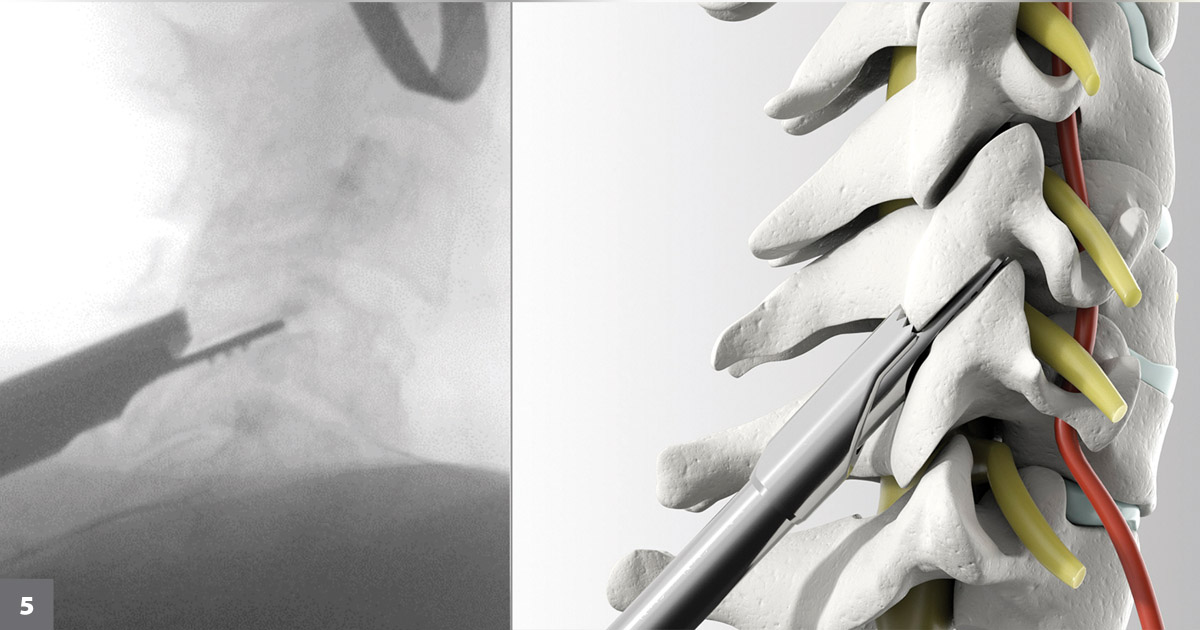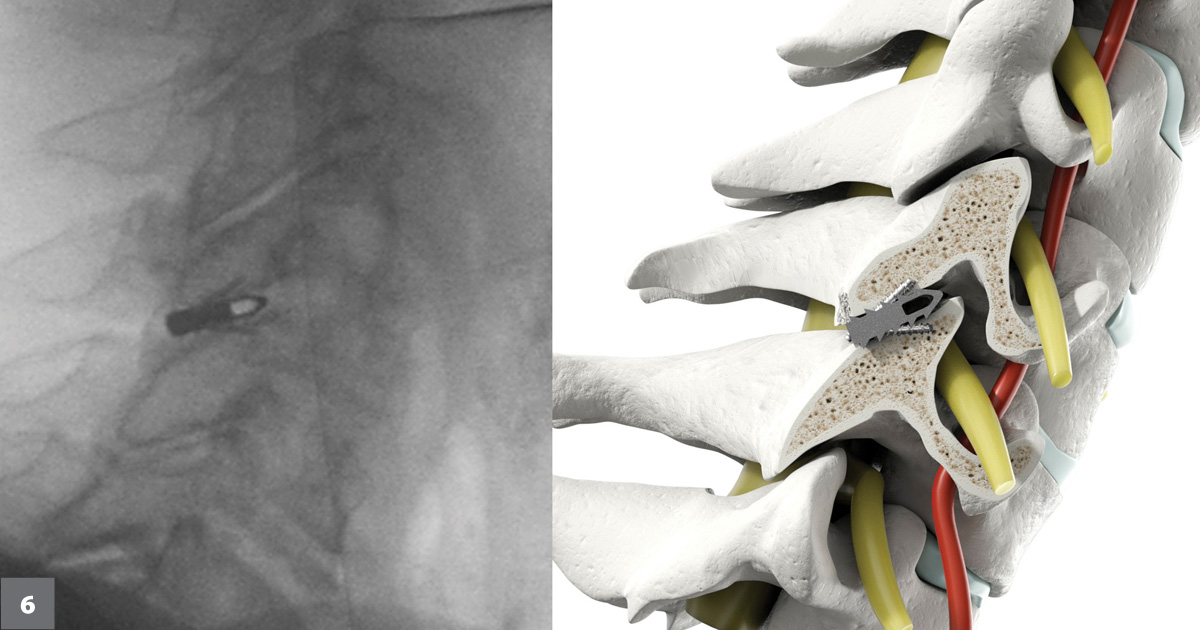Minimally invasive posterior cervical fusion augments three-level cervical fusion
Cervical degenerative disc disease occurs when the functional spinal unit breaks down. It can lead to disabling pain and neurological dysfunction, particularly when spinal nerves or the spinal cord is impinged.
When multiple levels are affected and are refractory to nonoperative treatment, surgical solutions can be considered. Surgical solutions encompass anterior cervical decompression and fusion (ACDF), posterior cervical decompression and fusion, and laminoplasty, depending on the degree of stenosis, location of stenosis and surgeon preference. ACDF is commonly used as a surgical solution for multiple-level neural compression.
An anterior approach offers the following advantages: direct decompression of pathologies in the anterior cervical spine (ie, osteophytes, ossification of the posterior longitudinal ligament, disc herniations); a muscle-sparing dissection to minimize postoperative pain, reduce infection rates; the ability to decompress and correct cervical kyphosis; and can be used in patients with prominent radiculopathy. Many spine surgeons prefer an anterior approach when one to two levels are involved. When three or more levels are involved and decompression and fusion is performed at three or more levels, complication rates with an anterior approach increase. These complications may include pseudoarthrosis, subsidence and dislodgement of graft.

In 2019, the spine committee of the World Federation of Neurosurgical Societies recommended posterior surgical techniques be used when three or more levels are involved. To optimize the chances for arthrodesis, 2013 appropriate use criteria from the North American Spine Society suggest an even lower threshold for posterior stabilization, when two or more levels are fused and when posterior fusion is indicated.
Additionally, arthrodesis and wound healing are hampered in patients with multiple-level disease and comorbidities, including diabetes, smoking, osteoporosis, increased frailty and steroid use.

Posterior-based cervical fusion, as an augment to ACDF, is not routinely performed secondary to extensive surgical blood loss, increased operative time, C5 radiculopathy/palsy, potential for screw misplacement, vertebral artery injury, dural tear, surgical site infection, overall neurologic deficits, adjacent segment pathology, proximal and distal junctional kyphosis, and pseudoarthrosis. There is a 15% to 25% incidence of complications in posterior cervical spine surgery.
Aside from these complications, posterior-based cervical fusion surgery of three or more levels was associated with longer length of hospital stay and higher hospital costs in a 2011 study by Zoher Ghogawala, MD, and colleagues.

While the reasons for avoiding initial circumferential fusion are numerous — highly selective inclusion criteria, the need for staging, premature adjacent-level deterioration and instability as a result of the creation of rigid, long-segment constructs — a common reason to avoid such fusion centers around additional morbidity with a posteriorly based procedure.
Although published series in the literature evaluate the use of tissue-sparing posterior cervical spinal fusion, these are retrospective in nature and do not have a control arm.

Source: Providence Medical Technology Inc.
The Study of Posterior Cervical Stabilization System (PCSS) as Part of Circumferential Fusion to Treat Multilevel DDD (FUSE) clinical trial is a prospective, multicenter, randomized, controlled study being conducted to evaluate the safety and efficacy of posterior cervical spinal fusion using a tissue-sparing approach to augment fusion results in multiple-level fusion surgery. It looks to enroll 330 patients and randomly assign them to a treatment arm or a control arm in a 1:1 ratio.
Patient selection
The treatment arm consists of anterior- and posterior-based cervical decompression and fusion using a semiconstrained anterior cervical plate and allograft in three contiguous levels anteriorly and a posterior tissue-sparing minimally invasive cage and screw construct posteriorly. The control arm consists of only the semiconstrained anterior cervical plate and allograft used anteriorly in three contiguous levels. Patients in the trial are blinded to the initial surgical arm.
Patients are followed for 2 years and are allowed to cross-over from the control arm to the treatment arm. They are not excluded for comorbidities, such as diabetes, osteopenia, and smoking.

Standard ACDF
The patient is placed in the supine position and undergoes standard anterior cervical decompression of affected levels. Pre-machined allograft bone is inserted into the decompressed levels with or without locally harvested bone according to the operating surgeon’s general practice. The decompressed area is plated using a semiconstrained plate with variable angle screws to allow for load-sharing. A drain is used according to surgeon preference.
Position of posterior cervical fusion
The patient is positioned on a radiolucent table with the head in neutral sagittal alignment. The cervical spine is in a natural lordotic position with blankets/gel rolled under the chest. The shoulders are taped down or a harness is used to help with visualization (Figure 1).
The C-arm is brought in and positioned at 90° orthogonal (Figure 2).
Clear images are obtained of the facet initially using the lateral view (Figure 3). The table angle is adjusted with table tilt and adjusting the C-arm angle until a clear picture of the facet joint is obtained. The anteroposterior (AP) view at 90° is identified and optimized to determine whether there is a cervical scoliotic deformity or, if there is suboptimal lateral view, the C-arm may need to be tilted on the AP view. The en-face view is identified and optimized to confirm the location of the instrumentation. Once imaging has been identified and optimized, the surgeon marks the landmarks for the medial and lateral aspect of the facet using fluoroscopy and a marking stick.
Posterior neck incisions
Use fluoroscopy and a spinal needle to aid in making an incision about two levels inferior to the affected disc. Advance the spinal needle toward the midpoint of the facet on the AP view and toward the inferior tip of the facet on the lateral view. Once this has been done, the first incision is made along the same trajectory as the spinal needle.

Source: Providence Medical Technology Inc.
Introduce the access chisel in line with the muscle fibers to make a vertical path through the thoracodorsal fascia. Use the AP view and lateral fluoroscopy while approaching the facet joint. The trajectory should be in a medial to lateral trajectory in the AP view (Figure 4). Rotate the access chisel so that it is collinear with the facet joint and the access chisel can enter into the facet joint in a medial to lateral trajectory. Once it is in the joint, confirm there is medial facet clear space with en-face imaging. Additionally, confirm that the tip of the chisel is at the anterior margin of the superior articular facet with lateral imaging.
Decortication of facet joint capsule
With the access chisel in position, remove the chisel handle to allow the decortication trephine to slide down over the chisel and onto the facet. Decorticate the joint capsule using the trephine while working on the inferior and superior facet joints deliberately, with no medial or lateral decortication, because this will displace the orientation of the access chisel (Figure 5). Once decortication is complete, remove the trephine.
Introduce the guide tube/working cannula over access chisel so that medial clear space is maintained and the anterior margin of superior articular facet is respected. The guide tube is advanced into the facet joint utilizing the fork mallet. Evaluate the depth of the guide tube within the facet by assessing the small notches at the base of the guide tube prongs.

Source: Providence Medical Technology Inc.
Decortication of facet joint surface
Remove the access chisel. Leave the guide tube within the facet joint. Ream out the inside of the facet joint using the “pineapple-tipped” decortication burr. Remove the burr and fill the space with the graft material.
Using the guide tube, deliver the PCSS (Providence Medical Technology) implant into the facet joints and orient the screws appropriately. Direct it superiorly or inferiorly according to the patient’s anatomy and tighten the screws bilaterally (Figure 6).
Leave the guide tube in the facet to allow for delivery of graft material. Deliver some of the bone graft material through the guide tube. Use the tamp to deliver the graft down the guide tube and into the joint. Remove the guide tube and tamp, irrigate the incision sites and close all skin incisions.
Postoperatively, patients will know to which procedure they were randomized. They will be followed with clinical examinations and radiographs and be assessed for general health parameters using the SF-36, as well as with neck-specific questionnaires. Initially, patients in both groups will wear a rigid cervical collar for 6 weeks followed by progressive mobilization once they are out of the collar. No external bone growth stimulation will be undertaken. Follow-up will occur at 6 weeks; and 3, 6, 12, 18 and 24 months.
Endpoints for the FUSE study are the presence or absence of arthrodesis, neurological function, pain, disability, as well as the need for additional surgery.
- References:
- Badiee RK, et al. J Spine Surg. 2020; doi:10.21037/jss.2019.11.01.
- Bajamal AH, et al. Neurospine. 2019; doi:10.14245/ns.1938274.137.
- Bakhsheshian J, et al. Global Spine J. 2017;doi:10.1177/2192568217699208.
- Bohinski, R. (2018, November). ACDF Surgery: Anterior Cervical Discectomy and Fusion. Retrieved Aug. 11, 2020, from https://mayfieldclinic.com/pe-acdf.htm.
- Bose B. J Spinal Disord. 2001;doi: 10.1097/00002517-200102000-00002.
- Ducker TB, et al (2015, March 13). Circumferential Cervical Spinal Fusion. Retrieved Aug. 11, 2020, from https://clinicalgate.com/circumferential-cervical-spinal-fusion.
- Fehlings MG, et al. J Neurosurg Spine. 2012;doi:10.3171/2012.1.SPINE11467.
- Ghogawala Z, et al. Neurosurgery. 2011;doi:10.1227/NEU.0b013e31820777cf.
- https://clinicaltrials.gov/ct2/show/NCT04229017
- Kim PK, et al. Spine J. 2006;doi:10.1016/ j.spinee.2006.04.025.
- Kramer S, et al. Global Spine J. 2020;doi.org/10.1177/2192568220911031.
- Hilibrand AS, et al. J Bone Joint Surg Am. 2001;doi:10.2106/00004623-200105000-00004.
- Poorman GW, et al. Int J Spine Surg. 2018;doi.org/10.14444/5034.
- Reitman CA. (2013, January 1). Appropriate Use Criteria Cervical Fusion [PDF]. Burr Ridge, Illinois: North American Spine Society.
- Sasso RC, et al. Spine (Phila Pa 1976). 2003;doi:10.1097/00007632-200301150-00009.
- Siemionow KB, et al. J Craniovertebr Junction Spine. 2017;doi:10.4103/jcvjs.JCVJS_61_17.
- Vaccaro AR, et al. J Spinal Disord. 1998;11:410-415.
- Voronov LI, et al. Medical Devices (Auckl). 2016;doi:10.2147/MDER.S109588.
- Xie JC, et al. Neurosurgery. 2007;doi:10.1227/01.neu.0000279730.44016.da.
- For more information:
- Olusegun K. Onibonoje, DO, is an orthopedic resident physician PGY 3. He can be reached at Inspira Medical Center, 1505 W. Sherman Ave., Vineland, NJ 08360; email: okonibonoje0418@email.campbell.edu.
- Anand B. Shah is a medical student. He can be reached at bshah.anand@gmail.com.
- Rahul V. Shah, MD, is an orthopedic spine and neck surgeon. He can be reached at Premier Orthopaedics and Sports Medicine of Southern NJ, 298 S. Delsea Dr., Vineland, NJ 08360; email: bbonilla@premierspinedr.com.
